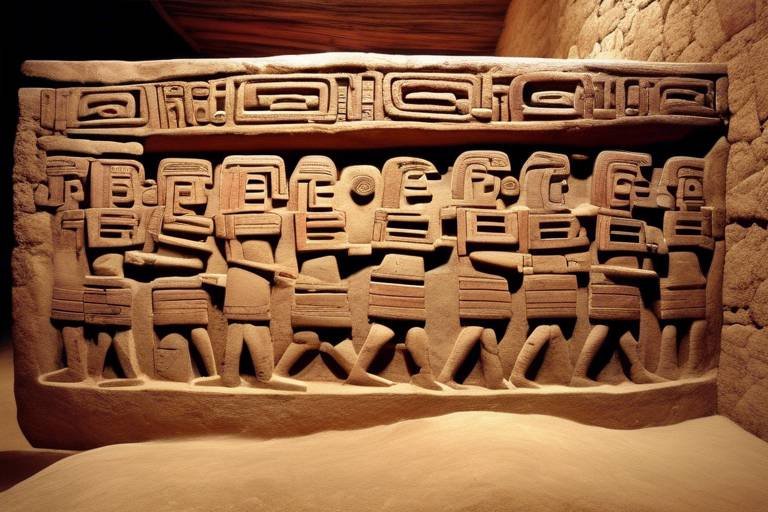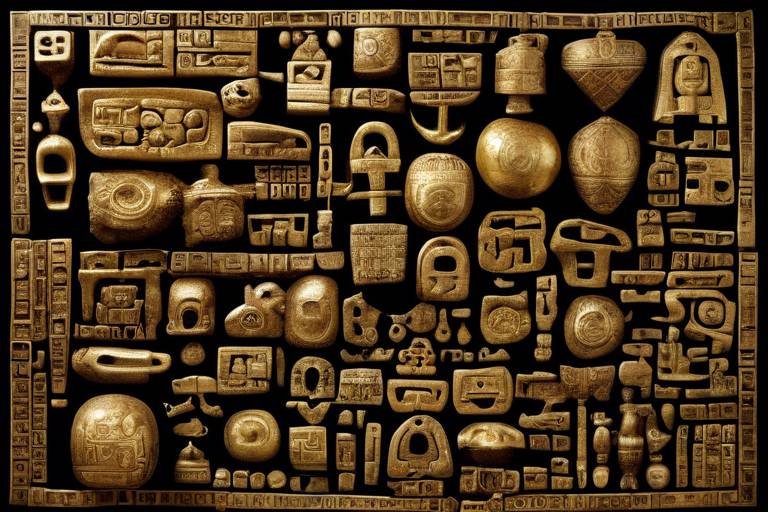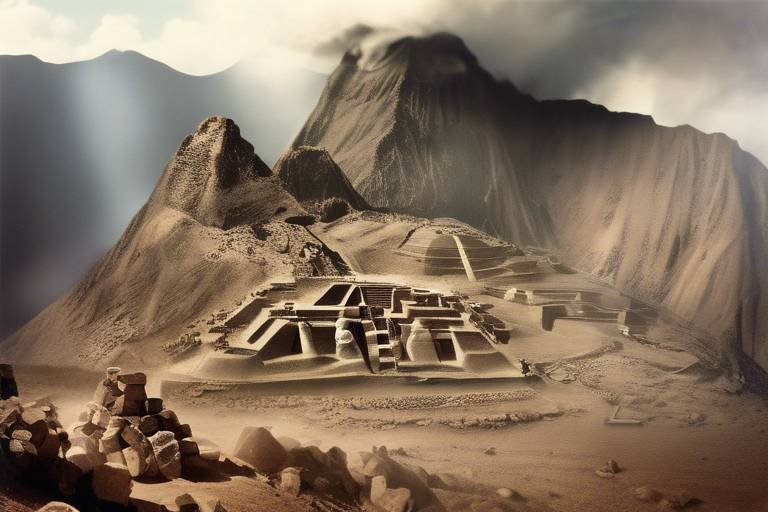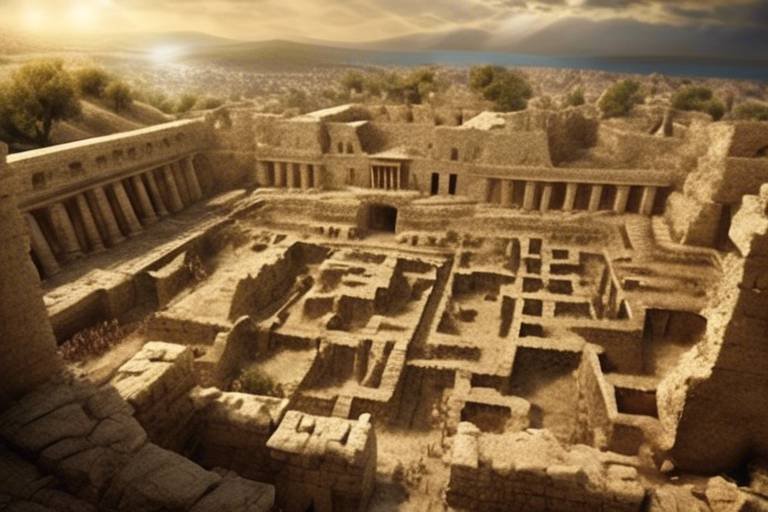The Rise and Fall of the Khmer Empire - A Detailed Study
The Khmer Empire, a once-mighty civilization that rose to prominence in Southeast Asia, has a historical journey filled with grandeur, power, and eventual decline. From its humble beginnings to its peak under formidable rulers like Jayavarman II and Suryavarman II, the empire's story is a testament to human ambition and achievement. However, as with many great empires, the Khmer Empire faced internal strife, external invasions, and environmental challenges that ultimately led to its downfall.
Established by Jayavarman II, the Khmer Empire unified various kingdoms in the region, laying the foundation for a powerful and centralized state. The capital city of Hariharalaya became a symbol of the empire's strength and ambition, showcasing its ability to consolidate power and resources for grand endeavors.
One of the most enduring legacies of the Khmer Empire lies in its architectural marvels, particularly exemplified by the breathtaking structures of Angkor. Angkor Wat, Bayon Temple, and other religious and administrative buildings stand as testaments to the empire's cultural sophistication and engineering prowess, drawing admiration from visitors and scholars alike.
Religious and cultural influences played a significant role in shaping the identity of the Khmer Empire. The integration of Hinduism and Buddhism, the development of Khmer art and literature, and the elaborate rituals and ceremonies reflected the empire's diverse and vibrant society, enriching its cultural tapestry.
As the empire expanded its territories through military conquests, conflicts with neighboring powers like the Champa and the Dai Viet arose. The strategic maneuvers and territorial gains in present-day Thailand, Vietnam, and Laos demonstrated the Khmer Empire's military might and ambition, but also exposed it to external threats and challenges.
Despite its glorious past, the Khmer Empire faced a gradual decline marked by internal power struggles, invasions by rival kingdoms, and the devastating impact of the Black Death. The once-thriving civilization succumbed to environmental degradation, including deforestation and drought, which further weakened its foundations.
However, the legacy of the Khmer Empire endures in modern Cambodia, influencing its culture, religion, and society. The preservation of Khmer traditions, the architectural influence on contemporary structures, and the revival of Khmer arts and dance reflect the lasting impact of this ancient civilization on the country's identity.
Recent archaeological discoveries and scholarly research have shed new light on the history and achievements of the Khmer Empire, offering fresh insights into its governance, economy, and social structures. These findings continue to expand our understanding of this remarkable civilization and its contributions to the region.
As tourism thrives in ancient Khmer sites like Angkor Wat, efforts to balance conservation with visitor numbers have become crucial. Sustainable tourism initiatives and conservation projects aim to protect the legacy of the Khmer Empire for future generations, ensuring that its rich history and cultural heritage remain accessible and preserved.

Establishment of the Khmer Empire
The Khmer Empire traces its roots back to the early 9th century when Jayavarman II ascended to power and embarked on a mission to unify disparate kingdoms in the region. His visionary leadership and strategic prowess culminated in the establishment of the Khmer Empire, marking the beginning of a glorious chapter in Southeast Asian history.
Under the reign of Jayavarman II, the capital city of Hariharalaya was founded, serving as the political and cultural heart of the burgeoning empire. This pivotal moment not only solidified the authority of the Khmer rulers but also laid the groundwork for the empire's expansion and influence across the region.
The architectural marvels of the Khmer Empire, epitomized by the awe-inspiring structures of Angkor Wat and the enigmatic Bayon Temple, reflected the grandeur and sophistication of Khmer civilization. These monumental edifices not only showcased the empire's engineering prowess but also served as testaments to its spiritual and cultural richness.
Religious and cultural influences played a pivotal role in shaping the identity of the Khmer Empire. The fusion of Hinduism and Buddhism created a unique religious landscape, while the development of Khmer art and literature flourished under royal patronage. Rituals and ceremonies permeated every aspect of society, reinforcing the spiritual fabric that bound the empire together.
As the Khmer Empire expanded its territorial reach through military conquests, it encountered both triumphs and challenges on the battlefield. Conquests in present-day Thailand, Vietnam, and Laos solidified Khmer dominance, while conflicts with neighboring empires tested the empire's military strength and diplomatic acumen.
However, the glory of the Khmer Empire was not destined to last forever. Internal power struggles, invasions by rival kingdoms such as the Ayutthaya Kingdom and the Champa, as well as the ravages of the Black Death, hastened the empire's decline. Environmental factors, including deforestation and drought, further exacerbated the challenges faced by the once-mighty empire.
Despite its eventual decline, the legacy of the Khmer Empire endures to this day, leaving an indelible mark on Cambodian culture, religion, and society. The preservation of Khmer traditions, the enduring influence of Khmer architecture on modern structures, and the revitalization of Khmer arts and dance all attest to the lasting impact of this remarkable civilization.

Architectural Marvels of Angkor
When it comes to the architectural marvels of Angkor, one cannot help but be awe-inspired by the grandeur and intricacy of the structures that stand as a testament to the Khmer Empire's power and cultural sophistication. At the heart of this architectural splendor lies Angkor Wat, a massive temple complex dedicated to the Hindu god Vishnu. Its towering spires and intricate bas-reliefs depicting mythological scenes leave visitors spellbound, showcasing the empire's devotion to religion and artistry.
Another iconic structure within the Angkor complex is the Bayon Temple, known for its captivating stone faces carved into the temple's towers. These enigmatic faces, believed to represent bodhisattva or the king himself, exude a sense of mystery and spiritual aura, inviting contemplation and admiration from all who visit. The Bayon Temple stands as a symbol of the empire's blend of Hindu and Buddhist influences, reflecting the cultural richness of the Khmer civilization.
Aside from these renowned landmarks, the Angkor region boasts a myriad of other religious and administrative structures that once served as centers of power and worship. The Terrace of the Elephants, with its intricate carvings and platforms, provided a grand stage for royal ceremonies and processions, while the Baphuon Temple, with its imposing pyramid structure, symbolized the empire's architectural prowess and engineering ingenuity.
Exploring the architectural marvels of Angkor is akin to stepping back in time and witnessing the grandeur of a civilization that thrived centuries ago. Each stone block, each intricate carving, and each towering spire tells a story of a bygone era, inviting us to marvel at the legacy left behind by the Khmer Empire and appreciate the enduring beauty of their architectural achievements.

Religious and Cultural Influences
The Khmer Empire was not only known for its military prowess and architectural marvels but also for its rich religious and cultural influences that shaped the society of that era. One of the most fascinating aspects of the Khmer Empire was its unique blend of Hinduism and Buddhism, which played a significant role in defining the religious landscape of the region. The rulers of the empire, such as Jayavarman II and Suryavarman II, patronized both Hindu and Buddhist practices, leading to a syncretic approach that influenced art, architecture, and daily life.
This religious syncretism was reflected in the magnificent temples and religious structures built by the Khmer Empire, such as the iconic Angkor Wat and the enigmatic Bayon Temple. These architectural wonders not only served as places of worship but also as symbols of the empire's power and devotion to spiritual beliefs. The intricate carvings and sculptures found in these temples depicted scenes from Hindu epics like the Ramayana and Mahabharata, as well as Buddhist teachings, showcasing the empire's cultural sophistication and artistic prowess.
Moreover, the Khmer Empire's cultural influences extended beyond religion to encompass art, literature, and societal practices. The empire's artists and artisans produced exquisite works of art, including intricate stone carvings, bronze sculptures, and pottery, which adorned temples and palaces. Khmer literature flourished during this period, with epic poems and historical chronicles being composed to celebrate the empire's achievements and chronicle its history.
Rituals and ceremonies played a crucial role in Khmer society, with elaborate ceremonies conducted to honor the gods, ancestors, and rulers. The empire's rulers were seen as divine incarnations, bridging the gap between the earthly realm and the spiritual world. Festivals and celebrations were held throughout the year to mark important events, harvests, and religious observances, bringing communities together in shared cultural experiences.

Expansion and Military Conquests
During its peak, the Khmer Empire was not only a cultural powerhouse but also a formidable military force that expanded its territories through strategic conquests. Led by ambitious rulers like Suryavarman II, the empire undertook military campaigns that extended its influence across present-day Thailand, Vietnam, and Laos. These conquests were not merely about territorial expansion but also about asserting Khmer dominance in the region.
One of the key military strategies employed by the Khmer Empire was the use of a powerful army equipped with advanced weaponry and well-trained soldiers. The empire's military prowess allowed it to subdue rival kingdoms and establish control over vast swathes of land. The conquests were not without resistance, as neighboring empires like the Champa and the Dai Viet posed significant challenges to Khmer expansion.
Moreover, the Khmer Empire's military campaigns were not limited to land conquests alone. The empire also maintained a formidable navy that patrolled the waters of the Mekong River and the Tonle Sap, enabling it to control important trade routes and maritime territories. This naval strength further solidified the empire's dominance in the region and facilitated the transportation of troops and resources during military expeditions.
As the Khmer Empire expanded its territories through military conquests, it also faced diplomatic challenges and alliances with neighboring states. These diplomatic maneuvers were crucial in maintaining a delicate balance of power in the region and securing strategic advantages against rival empires. The empire's ability to forge alliances and negotiate treaties played a significant role in its military successes and territorial acquisitions.
Overall, the expansion and military conquests of the Khmer Empire were a testament to its ambition, military strength, and strategic acumen. The empire's ability to project power across vast distances, both on land and sea, solidified its position as a dominant force in Southeast Asia during its golden age.

Decline of the Khmer Empire
As we delve into the decline of the once-mighty Khmer Empire, we uncover a complex tapestry of internal conflicts, external pressures, and environmental challenges that ultimately led to its downfall. The empire, which had reached its zenith under rulers like Suryavarman II, faced a gradual erosion of power and influence in the centuries that followed.
One of the significant factors contributing to the decline of the Khmer Empire was the internal strife and power struggles among the ruling elite. Succession disputes and court intrigues weakened the central authority, leading to a fragmentation of the empire and making it vulnerable to external threats.
External invasions also played a crucial role in the empire's decline. The Ayutthaya Kingdom, located to the west of the Khmer territories, launched incursions into Khmer lands, further destabilizing the region. Additionally, conflicts with neighboring empires like the Champa and the Dai Viet put immense pressure on the Khmer Empire's borders.
Furthermore, the impact of the Black Death, a devastating pandemic that swept through Asia in the 14th century, decimated the population and disrupted the economy of the Khmer Empire. The loss of manpower and economic productivity dealt a severe blow to the empire's ability to maintain its territorial holdings and defend against external threats.
Environmental degradation also played a significant role in the decline of the Khmer Empire. Deforestation, primarily driven by the need for resources to sustain the empire's massive building projects, led to soil erosion and changes in local climate patterns. Coupled with periods of drought, these environmental factors contributed to agricultural decline and food shortages, further weakening the empire's foundations.
In the face of these multiple challenges, the once-great Khmer Empire gradually lost its grip on power and influence, paving the way for its eventual collapse and the rise of new regional powers in Southeast Asia. The legacy of the Khmer Empire, however, continues to endure in the cultural heritage of modern-day Cambodia and serves as a reminder of the ebbs and flows of history.

Legacy of the Khmer Empire
The legacy of the Khmer Empire is deeply ingrained in Cambodian culture, leaving a lasting impact on various aspects of society. One of the most prominent legacies is the preservation of Khmer traditions, which continue to be celebrated and practiced to this day. The empire's influence on religion, particularly the integration of Hinduism and Buddhism, has shaped the spiritual beliefs of the Cambodian people, creating a unique blend of faiths that is still evident in religious practices.
Furthermore, the architectural marvels of the Khmer Empire, such as Angkor Wat and Bayon Temple, have not only stood the test of time but also inspired modern structures around the world. The intricate carvings, grandeur, and sheer scale of these monuments showcase the empire's architectural prowess and cultural sophistication, serving as a testament to the empire's once-mighty reign.
In addition to tangible legacies, the Khmer Empire's impact on arts and literature is profound. The development of Khmer art, characterized by intricate stone carvings and sculptures, continues to influence contemporary Cambodian artists and craftsmen. Traditional Khmer dance forms, rooted in ancient rituals and ceremonies, have also been preserved and revived, showcasing the empire's cultural richness and artistic heritage.
Moreover, the legacy of the Khmer Empire extends beyond Cambodia's borders, with its architectural and cultural influence reaching neighboring countries in Southeast Asia. The empire's legacy serves as a source of national pride for Cambodians, fostering a sense of identity and connection to their rich historical roots.

Modern Discoveries and Research
Modern Discoveries and Research have brought new dimensions to our understanding of the Khmer Empire's history and achievements. Recent archaeological excavations have unearthed hidden treasures that offer valuable insights into the empire's governance, economy, and societal structures. Scholars have meticulously analyzed these findings, piecing together the puzzle of the empire's past.
One of the most significant discoveries in recent years is the identification of previously unknown temples and structures within the vast Angkor complex. These findings have expanded the known extent of Khmer architectural prowess and shed light on the empire's urban planning and religious practices. The intricate carvings and inscriptions found in these newly uncovered sites have provided clues to the daily life and beliefs of the Khmer people.
Furthermore, advanced technologies such as LiDAR (Light Detection and Ranging) have revolutionized the way we explore ancient civilizations. By using aerial surveys and laser scanning, researchers have been able to map out hidden urban centers, irrigation systems, and road networks that were once invisible beneath the dense jungle canopy. This non-invasive technique has enabled a more comprehensive understanding of the scale and complexity of the Khmer Empire's infrastructure.
Moreover, interdisciplinary studies combining archaeology, anthropology, and environmental science have revealed the interconnected nature of the Khmer society with its surrounding landscape. Researchers have uncovered evidence of sophisticated water management systems, agricultural practices, and trade networks that sustained the empire's population and facilitated its economic prosperity.
Overall, the ongoing research and discoveries related to the Khmer Empire continue to captivate both scholars and the public alike. By unraveling the mysteries of this ancient civilization, we not only honor the legacy of the Khmer people but also gain valuable lessons about resilience, innovation, and the enduring impact of human endeavors throughout history.

Tourism and Conservation Efforts
Tourism plays a significant role in showcasing the grandeur of ancient Khmer sites like Angkor Wat to the world. The influx of visitors has brought both admiration and challenges to the conservation efforts of these historical treasures. As millions of tourists flock to marvel at the architectural marvels of the Khmer Empire, there is a growing need to balance preservation with accessibility.
Conservation efforts are paramount in ensuring that these ancient wonders stand the test of time. Various initiatives have been implemented to safeguard the structural integrity of temples and monuments while educating visitors about the importance of respecting these cultural heritage sites. Preservation projects focus on maintaining the intricate carvings, intricate bas-reliefs, and iconic structures that define the Khmer Empire's legacy.
Challenges arise as the popularity of sites like Angkor Wat continues to rise. Managing the impact of tourism on these fragile archaeological wonders requires a delicate balance. Issues such as overcrowding, wear and tear from foot traffic, and unauthorized restoration attempts pose threats to the preservation of these invaluable historical sites.
Efforts to promote sustainable tourism aim to mitigate these challenges by implementing visitor management strategies, promoting responsible travel practices, and raising awareness about the significance of preserving cultural heritage. Collaborative endeavors between local authorities, conservation organizations, and the tourism industry are crucial in safeguarding the authenticity and beauty of the Khmer Empire's architectural masterpieces for future generations to admire.
Frequently Asked Questions
- What was the significance of Angkor Wat in the Khmer Empire?
Angkor Wat was a symbol of the Khmer Empire's architectural and cultural achievements. It served as a religious center, a political capital, and a testament to the empire's power and sophistication.
- How did the Khmer Empire integrate Hinduism and Buddhism?
The Khmer Empire embraced both Hinduism and Buddhism, with rulers patronizing temples dedicated to both religions. This integration led to a unique blend of beliefs and practices in Khmer society.
- What were the main factors that contributed to the decline of the Khmer Empire?
The decline of the Khmer Empire was influenced by internal conflicts, external invasions, the spread of diseases like the Black Death, and environmental issues such as deforestation and drought.
- How has the legacy of the Khmer Empire influenced modern Cambodian culture?
The legacy of the Khmer Empire is evident in Cambodian traditions, architecture, and arts. It continues to shape the cultural identity of Cambodia and inspire contemporary artistic expressions.
- What recent archaeological discoveries have shed new light on the Khmer Empire?
Recent discoveries have provided insights into the governance, economy, and societal structures of the Khmer Empire. These findings have expanded our understanding of the empire's achievements and historical significance.
- How are tourism and conservation efforts impacting ancient Khmer sites?
Tourism has brought both benefits and challenges to ancient Khmer sites like Angkor Wat. Conservation efforts aim to balance the preservation of these heritage sites with the demands of sustainable tourism and visitor management.



















